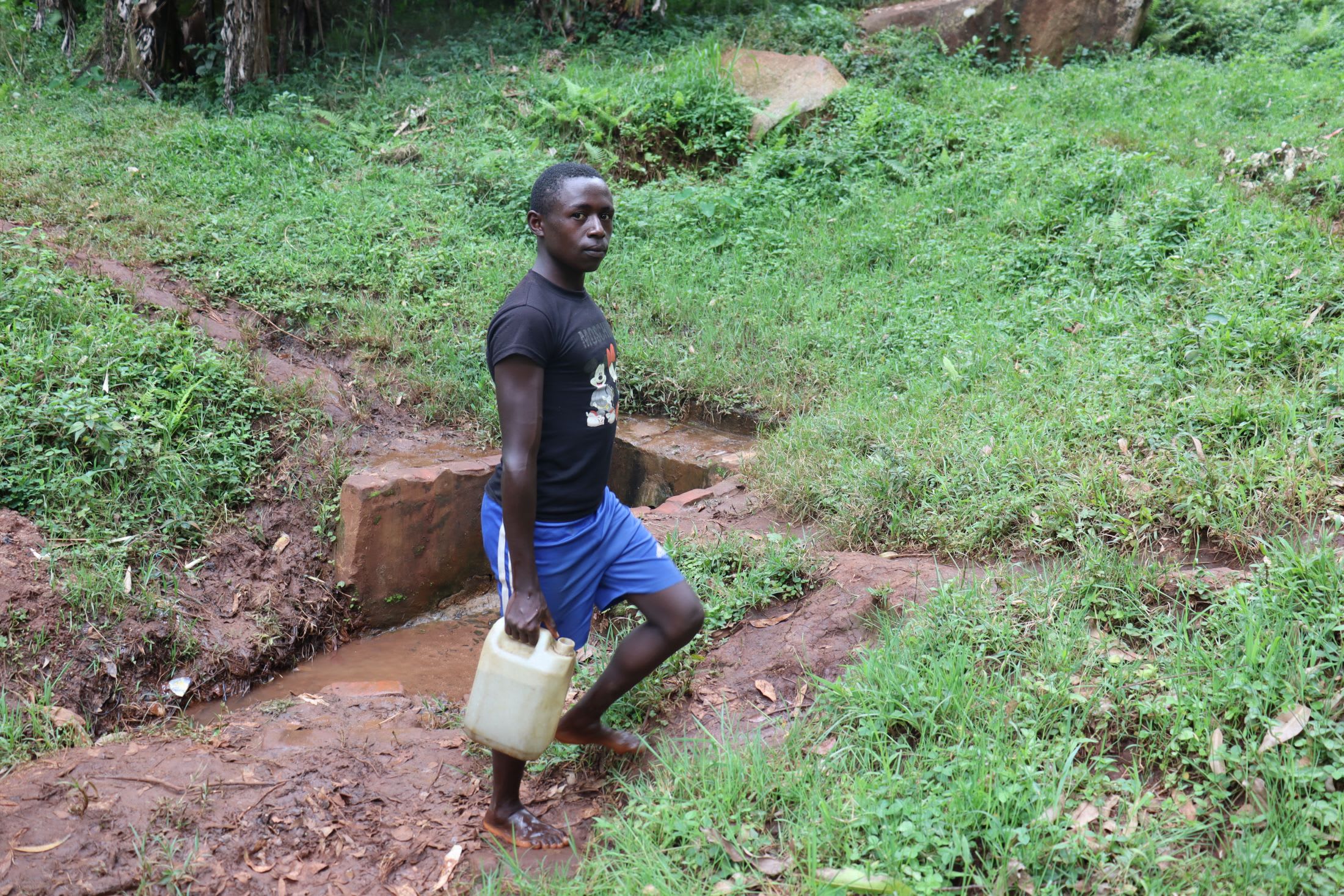It has been ten years since the 300 community members in the Matuga Community have had access to a safe, reliable water source to meet their needs. Their community water source, Matuga Spring, was once protected, but now it is no longer safe. The water is contaminated and the structure is crumbling.

Community members waiting at the spring needing protection.
"This waterpoint has serious challenges. There is [an] overflow of water above the headwall, pooling in the collection area, a blocked drainage channel and there is significant damage to the headwall with water oozing through it. The water is cloudy and leaves some sediment when put in a container. The stairs have completely collapsed," shared Field Officer Daniel Mwanzia.
"This waterpoint has been in a state of disrepair for a while. The water users tried to repair the headwall, but that didn't yield much," Mr. Mwanzia continued.

A community member collecting water.
Because community members have no choice but to use the spring water, those who consume it inevitably suffer from water-related illnesses that steal their health, time, and resources.
17-year-old Julius shared his experience.

Julius.
"I attend a boarding school in a different part of the country. When away from home, I'm okay, but every time schools close, I get sick after using water from this source. I dread school holidays because of this," shared Julius.
"In our school calendar, the November-December holiday is the longest. We normally stay home for at least two months. A day [before] the January reopening, I fell so ill that I couldn't do anything! I had severe abdominal pains accompanied by diarrhea and fever. Upon visiting the nearby dispensary, I was diagnosed with amoebiasis, which the doctor confirmed was caused by drinking contaminated water," Julius continued.
"My mom took me to [the] hospital where the illness was confirmed to be amoebiasis. I was given intravenous drugs and kept in [the] hospital overnight for observation. The following day, I was discharged after the doctor was satisfied I would be okay with the drugs he had prescribed for me. When I was diagnosed with amoebiasis, I became so weak and couldn't go back to school after reopening. I had to stay home for another two weeks!" Julius declared.

Julius at the unprotected spring.
"Collecting water has become a difficult, risky, and time-consuming affair. The threat of catching diseases hangs on our necks every single day, and that has instilled fear in my community!" said Julius.
Julius worries about his mother who stays in their community when he is at boarding school. Not only does he fear her becoming ill, but without her help, it would be impossible for him to attend school and fulfill his dreams.
"I wouldn't want my mother or anyone else in my community to get hurt as they go to fetch water. My mom works so hard to keep me in school, and if anything were to happen to her, I'd be devastated," he continued.

"I'd love to become a doctor so as to be a blessing to my family, neighbors, and community in general. I have grown up in hardship and would jump at any chance to change the lives of my family members and community."
Properly protecting the spring will enable Julius, his mother, and their community to consistently access safe water, preserve their health, and make progress in their daily lives with the resources they work so hard to attain.
Steps Toward a Solution
Our technical experts worked with the local community to identify the most effective solution to their water crisis. They decided to safeguard the existing flowing spring.
Spring Protection
Springs are natural water sources that originate from deep underground. As water travels through various layers of the earth, it undergoes a natural filtration process, making it cleaner and safer to drink. To protect these spring sources from contamination, we construct a waterproof cement structure around layers of clay, stone, and soil. This design channels the spring water through a discharge pipe, facilitating easier, faster, and cleaner water collection.
Chlorine Dispenser
As an extra measure towards water quality safety, uniquely engineered chlorine dispensers are installed at all of our spring protection projects so community members can treat their water with pre-measured doses of chlorine. The chlorine treats any residual contamination and stays active for two to three days, ensuring water stays safe to use even when stored at home. Chlorine delivery and maintenance of the dispensers are part of our ongoing community support.
Community Education & Ownership
Hygiene and sanitation training are integral to our water projects. Training is tailored to each community's specific needs and includes key topics such as proper water handling, improved hygiene practices, disease transmission prevention, and care of the new water point. Safe water and improved hygiene habits foster a healthier future for everyone in the community. Encouraged and supported by the guidance of our team, a water user committee representative of the community's diverse members assumes responsibility for maintaining the water point, often gathering fees to ensure its upkeep.

 Protected Spring
Protected Spring
 Rehabilitation Project
Rehabilitation Project
















